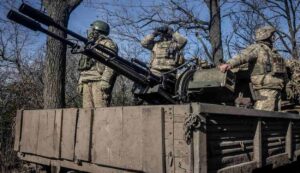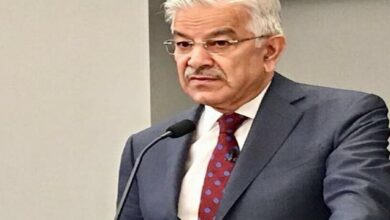Russia: Moscow has the “right” to attack Western countries that provided Kiev with weapons used against Russian targets
Russia successfully launched a hypersonic missile with a conventional payload in Ukraine, according to Russian President Vladimir Putin, who also warned that Moscow “had the right” to attack Western nations who supplied Kyiv with weapons to use against Russian targets.

Putin said that there are “no countermeasures for the Oreshnik missile” at the moment in a broadcast speech on November 21 evening. He also promised that Russia would notify the public before deploying this kind of missile, according to official media.
“We will do it due to humanitarian concerns – openly, publicly, without any concerns about any countermeasures from the enemy, who will also receive this information,” Putin said to TASS news agency.
“Why without any worries? Because there aren’t any countermeasures for this weapon right now,” the Russian news site quoted Putin as saying.
According to the TASS report, the new Oreshnik medium-range hypersonic ballistic missile, which was deployed for the first time and hit a defense industrial facility in Dnepr (formerly Dnepropetrovsk), was equipped with a conventional warhead but can also carry a nuclear charge.
According to Putin, Russia has the right to deploy its weapons against military installations of nations that permit the use of their weapons against Russian targets. The Russian leader was quoted as adding that Russia would warn ahead of time when it uses Oreshnik in the future, enabling residents to evacuate areas that have been classified as unsafe.
In his broadcast speech, Putin claimed that the strike was a response to Russian strikes by British-made Storm Shadow missiles and US-made ATACMS.
Russia claimed to have used the nuclear-capable hypersonic ballistic missile, which this time only carried a conventional warhead, to strike the Ukrainian aerospace factory Yuzhmash. Putin was quoted by Russian state media as claiming that the missile’s creators gave it the codename Oreshnik, which roughly translates to “hazelnut tree.”
According to Russian official media, the Oreshnik strikes targets at Mach 10, or 2.5–3 kilometers per second, and the American missile defense and air defense systems in Europe are unable to stop these missiles.
According to the deputy Pentagon press secretary, the US Department of Defense is referring to the new missile type that Russia launched against Ukraine as a “intermediate-range ballistic missile,” or IRBM, because it is the first time that such a weapon has been used on the battlefield in Ukraine.
Sabrina Singh said, “I can confirm that Russia did launch an experimental intermediate range ballistic missile,” during a Pentagon briefing on November 21.
The Russian RS-26 Rubezh intercontinental ballistic missile served as the basis for this IRBM. Regarding notifications to the US, she said that the US was briefly informed before to the launch via nuclear risk reduction channels.
Singh said that an intercontinental ballistic missile and an IRBM may carry heavy loads and have comparable flight paths and high trajectories. “But the main difference lies in the range and the strategic purpose,” she said.
The Multiple Independently-targetable Reentry Vehicle (MIRV) weapon, according to a CNN explanation, contains a number of warheads that can individually target a particular place, enabling one ballistic missile to perform a more extensive strike. In order to deliver multiple nuclear warheads with a single launch, MIRVs were developed during the Cold War. MIRVs are part of the States’ ICBM, the Minuteman III.
Putin’s comments have also been characterized by the Pentagon as “dangerous, reckless rhetoric.”
According to a post on X, Ukrainian President Volodymyr Zelensky called Russia’s launch of the latest medium-range ballistic missile “a cynical violation” of the UN Charter and described it as “a clear and severe escalation in the scale and brutality of this war.”
Zelensky urged foreign leaders to exert pressure on Moscow, claiming that Putin’s actions are “testing” Kyiv’s allies. Zelensky said that Russia was taking a “second step toward escalation,” claiming that the first stage was the inclusion of North Korean forces in the conflict.
Up until 2019, Russia and the United States were both signatories to the 1987 Intermediate-Range Nuclear Forces Treaty, which prohibited the testing and use of missiles with a range of 310–3,400 miles.
In 2019, the United States and Russia both resigned from the INF accord.
According to TASS, Putin said in his broadcast speech yesterday that the US erred by unilaterally nullifying the INF Treaty in 2019 on a “far-fetched pretext.”
The US Defense Department, meanwhile, said earlier this week that it will provide Ukraine with antipersonnel landmines.
American Defense Secretary Lloyd Austin stated, “What we’ve seen most recently is because the Russians have been so unsuccessful in the way that they have been fighting they’ve kind of changed their tactics a bit and they don’t lead with their mechanized forces anymore,” during the 14th ASEAN Defence Ministers Meeting Plus in Laos. “They lead with dismounted forces who are able to close in and do things to kind of pave the way for mechanized forces,” he said.
He said that the Ukrainians have begun producing their own landmines to impede Russian advances in response to shifting tactics.
Additionally, the United States announced a new security assistance package for Ukraine for USD 275 million, the 70th installment of funding since August 2021. Critical capabilities such as HIMARS munitions, artillery, anti-tank weapons, drones, and protective gear are provided under this Presidential Drawdown Authority package.
Following Russia’s combat test of its new Oreshnik hypersonic intermediate-range missile, the Pentagon spokeswoman informed reporters at her briefing yesterday that the US has no plans to update its nuclear posture.
“We haven’t seen any adjustments that we’ve observed in their nuclear posture, and we haven’t adjusted our nuclear posture in exchange,” she said.
Putin authorized modifications to Russia’s nuclear weapons doctrine earlier this week on Tuesday. It declares that any assault against Russia perpetrated by a non-nuclear state with the assistance or involvement of a nuclear state would be regarded as a joint attack. A conventional strike on Belarus or Russia that “creates a critical threat to their sovereignty or territorial integrity” might result in the deployment of nuclear weapons, according to Russia.
It went on to say that the goal of nuclear deterrence is not only to stop other nuclear powers but also to stop nations that let the preparation or execution of attack against it using their air, sea, or land.
Putin approved the nation’s new nuclear policy, the Foundations of State Policy in the Field of Nuclear Deterrence, with a signed order.
Dmitry Peskov, the spokesperson for the Kremlin, has issued a warning, stating that the use of Western non-nuclear weapons against Russia might potentially result in a nuclear reaction under Russia’s revised nuclear strategy. He had previously said that the United States’ decision to let Ukraine to launch an assault deep into Russia using American missiles was a “qualitatively new round of escalation of tensions.”





